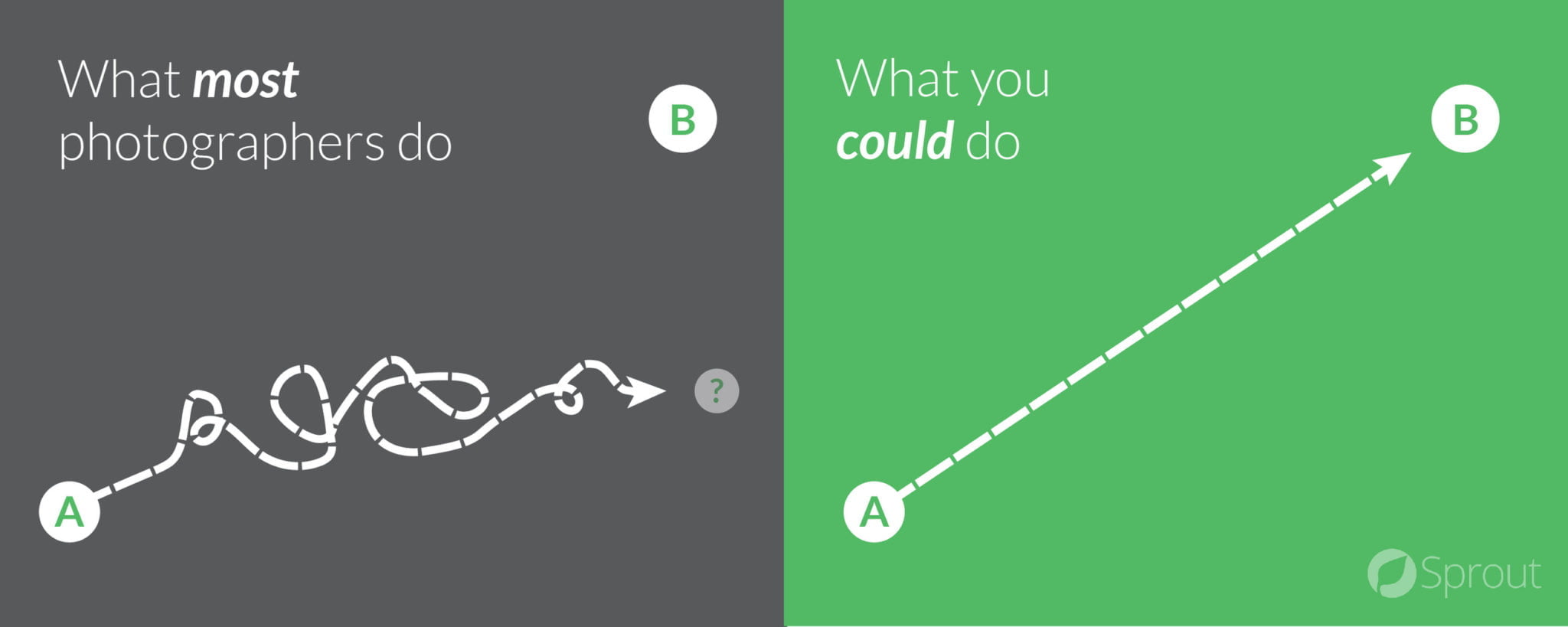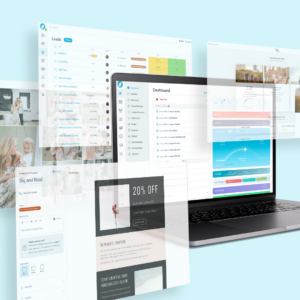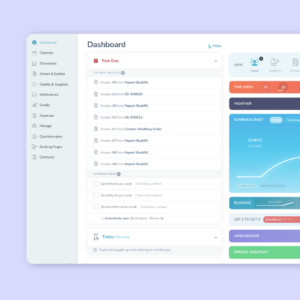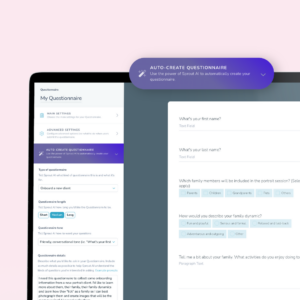You want success as a photographer, but do you know how to get there?

Success can actually be quite simple when you follow a few very specific guidelines. There is a linear path to get from where you are (point A) to where you want to be (point B). Most photographers don’t follow that simple path, though; they end up spending time doing things that don’t move them in the right direction. Even for those who do eventually connect point A to point B, it ends up taking them way longer, and they end up wasting opportunities along the way.
Will you follow the simple path to success – the one with the least amount of friction?

What barriers are in your way?
It was a Thursday afternoon in November of 2009.
I was in a small meeting room off to the side of a coffee shop in Niagara Falls with a group of 20 other local photographers. Every month, we got together to talk shop, discuss business ideas and share new discoveries. Sometimes we went out and photographed together, and other times we gathered to brainstorm ideas.
At this particular meeting, we were discussing pricing. Photographers struggle with pricing – putting value to the work we create is a very personal thing. Often, photographers aren’t comfortable doing it.
In having the discussion on pricing, one photographer said “I can’t charge what some of you guys charge, I’m not a professional yet. Once I am, though, I’ll increase my prices and start making more money.”
Several other photographers agreed and remarked similar sentiments. Another said “Once I get a studio, I’ll be much more comfortable and confident charging more for my print prices. Until then, I have to be competitive.”
I interrupted both of them with the question – “So what does that look like?”
Often we put up barriers in our head, but we don’t actually know what the barrier is. We don’t even consider if there’s actually even a barrier in the way, to begin with.
Often we put up barriers in our head, but we don’t ever actually know what that barrier looks like; just that there’s something in the way. We don’t ever consider what it takes to overcome the barrier. Heck, we don’t even question if there’s actually even a barrier in the way, to begin with.
“What does it look like?” – A question I often ask myself (and other photographers) as a shortcut to clarity. I encourage you to ask yourself that question, too.
Asking yourself the difficult question
Maybe you’re like the photographer who didn’t feel like a professional yet. Maybe you’re like the photographer waiting to get a studio before you implement some new ideas.
My question to you, too, then is this – “what does that look like?”
How will you know that you are a professional? How will you know that it’s the right time to get a studio? How will you know that you’ve reached, completed or achieved whatever barrier you’ve put up in your head?
What specifically does that look like? If you don’t define these barriers, then they’ll be a constantly moving target.
The shortcut to getting complete clarity
Back at the coffee shop, after I asked the question “what does that look like,” the photographer who said she didn’t feel professional was giving it some thought. She responded, “Well, once I feel like my photography is good enough and once I am more in line with the other photographer’s work in the area.”
The answer still felt vague and non-committal. So I asked her again “what does that look like?”
She seemed perplexed.
For clarification, I asked her “Do you have clients who book you and pay you money?” to which she answered “Yes.” I then asked “Do those clients sometimes look around at other photographers before they book you?” to which she answered “Yes.”
I went on to question “So to those clients, wouldn’t you say it’s true that they prefer your work over other photographer’s work in the area?” to which she answered, “Yeah, I guess so.”
You could see that she was starting to understand where I was going.
The walls you build up are not only stopping you from growing, but they’re stopping you from moving at all.
She had built this wall in her head that was stopping her from growing and increasing her prices. More importantly, though, that wall was stopping her from taking herself seriously as a professional. It was affecting her confidence, her self-awareness, and her pride.
I then asked “Wouldn’t you say that because you have clients who view you as equal (if not better) than some of the other photographers in the area, based on your definition, that would constitute you as being a professional?” to which she said “Damn it – you’re right!”
Defining point A and point B
The importance of getting clarity on your goals, your hopes, and your ambitions cannot be emphasized enough.
Furthermore, it’s even more important to understand and define your own barriers.
In this article, you will:
- Understand how to make the best use of your time.
- Get clarity on where to focus your energy.
- Know exactly how to get from where you are to where you want to be with the least amount of friction possible.
- Learn exactly how to evaluate opportunities that will unlock your ability to grow.
Before we get there, though, you need to have complete clarity on where you are, and where you want to be. Consider this – most people spend more time planning a vacation than they do planning their life or their business. I’m simply asking you to give your business plan and life plan some thought. I’m asking you to give it some level of intention. I’m asking you to understand, with complete clarity, exactly where you’re trying to get.
Creating a growth framework
Let’s create a growth framework together, so you understand exactly where you are, exactly where you’re going and exactly how to get there.
By the end of our conversation today, you’ll have the tools to build your own growth framework.
There are two obvious points in our growth framework that we need to define, and they are:
- Where you are.
- Where you want to be.
By getting clarity as to the beginning and the end, it allows you to create milestones along the way and design the simplest path connecting the points.
Picture yourself in 5 years
First, establish what the end-goal looks like. Begin with the end in mind. What is point B?
Picture yourself in 5 years – you’ve reached “success” as a photographer, and you’re running the business of your dreams. What specifically does that look like?
Get as detailed as possible in mapping out your goal. Are you full-time, charging $5,000 on average per wedding and running a boutique studio with three full-time employees? Or are you running a lifestyle business where you only work 20 hours per week, making a personal income of $60,000 and enjoying lots of time off with your family?
Design what you want your life to look like, and design your business to serve that need.
Write down what you want your business to look like and what you want your life to look like as a result. Better yet, design what you want your life to look like, and design your business serve that need.
If that photographer in the coffee shop back in 2009 never defined what “professional” looked like, she never would have known when she got there. The same is true for you – if you don’t define what success looks like, you’ll never know when you get there.
From your goal, extract a few specific and measurable metrics. For example – you want to charge $5,000 on average for a wedding and have three full-time employees. Now, define what those metrics are today. Maybe today you charge $2,000 on average for a wedding and have one part-time subcontracted employees.
You now have a clear starting point (point A) and a clear end point (point B) that are both measured using the same metrics. You also have the measuring stick to check-in with along the way to make sure you’re on the right path. If you charge $2,000 for an average wedding today and in 5 years you want to be charging $5,000, then you know you’ve got to raise your prices over the next five years. You must do it gradually; you won’t do it the day before that day five years from now.
What you measure, you improve. Make sure you’re measuring what you want to improve!
Having clarity on these metrics, making them available and constantly measuring them gives you an indication (positive or negative) that you’re working towards your goal and that you are moving in the right direction. It’s true that what you measure, you improve.

Breaking through the barriers
You now know where you are and where you’re going.
First of all, let me say “congratulations” because most photographers never even get this far. Most photographers are constantly reacting and are stuck making assumptions. They’re left putting those barriers up that stop them from seeing where they really are. Most photographers never break through the barriers, they just try and find a way around it. When you have a habit of creating barriers (and most of us do), you never find a way around them, because you just keep putting more up.
You must break through the barriers and break the habit of building new ones.
By creating specific and measurable outcomes, defining the barriers and getting clarity on what is really in the way, you can smash through them. Success is waiting on the other side.
How to eliminate the noise and focus
There are many different paths you could follow to get from where you are to where you want to be.
There’s almost an unlimited number of ways you could spend your time to connect the dots. There is certainly never a shortage of ideas or opportunities that promise potential growth.
While it’s true that there are an unlimited number of opportunities, and I’m sure many of them will move you towards your goal, there are only a few of them that will actually move you towards your goal in the time you want. Many of them will move you from point A to point B, but only a few will do so in a linear fashion.

In all the clutter and endless possibilities, there are a few ideas and opportunities that will skyrocket you to success and keep you on your path. The rest is just noise.
Looking for the small hinges
Small hinges move big doors.
It’s true that the largest and heaviest doors can be swung open by the tiniest of hinges. In the context of this conversation, it means that you can reach your biggest goals and ambitions with the smallest of ideas. The key is that they must be the right ideas.
When you pull the right levers in your business, you will skyrocket your career and catapult yourself into success.
How do you find out which ones, though? We’re providing a framework here for you so you can easily see which ones are worth pursuing.
In this conversation today, we’ll be creating a framework together. By the end, you’ll know exactly how to measure and analyze which opportunities are worth pursuing.
But first, there are five core competencies we must discuss:
- Action – You must do. Success doesn’t wait for those who are lazy, and if you want to move on the path to success, you must actively chase it. You must become a do’er!
- Consistency – You must have consistency in your action. It cannot come-and-go in waves. Otherwise, your path will end up looking like the mess of spaghetti that most photographer’s deal with.
- Intention – Don’t confuse motion for progress – you must act and act with intention. You must move towards your goal in a very deliberate and purposeful way. The intention is key, which is why we spent the first part of this conversation focused on defining our goals, so we know where we’re moving. It helps us act with intention.
- Measurement – You must have a way of measuring your progress, so you know if you’re moving in the right direction.
- Criticism – You need to be critical of yourself. You need to not accept anything for face value, and you need to question everything you’re considering doing. Deploying this as a practice will help you make better decisions, be less reactionary and make the most of those decisions you do make.

Creating a measuring stick for analyzing opportunities
The Growth Potential Indicator Score is a theory and formula I have come up with to help you gauge the potential impact of any opportunity.
It gives you a measuring stick to check whether something is worthwhile pursuing. This way, you know that you’re focusing on the right things, and are moving in the right direction.
You can measure any opportunity you’re considering in its ability to move you towards your goals. For example, maybe you’re thinking of:
- Running a promotion
- Choosing a marketing channel
- Creating a mini-session event
- Throwing a sale
- Going to a workshop
- Buying a new piece of software
- Implementing a new system
Using the Growth Potential Indicator Score allows you to think intentionally about an opportunity. To evaluate every opportunity across a standardized rating, we need the lowest common denominator. So, for any opportunity, what can we measure? What metrics indicate that an opportunity would deliver potential growth?
I believe there are three main indicators of growth:
- Does the opportunity increase profitability?
- Does the opportunity increase efficiency or save you time?
- Does the opportunity improve your skill-set?
I wrote an article on the Growth Potential Indicator Score here, but I’ll quickly give you the summary, below.
Interested in getting the Growth Potential Indicator Score spreadsheet so you can compare all the opportunities you’re considering and know which ones to pursue?
Download the Growth Potential Indicator Score spreadsheet!
Does the opportunity increase profitability?
The first indicator of growth is whether an opportunity positively affects profitability. And, when broken down into simple terms, profitability is measured as:
Profit = (# of Clients x $ per Client) – Expenses
The biggest impact on profitability is the number of clients you have and the amount you make per client.
It’s not that decreasing your expenses wouldn’t positively affect profitability. It would. I just believe that for most photographers, expenses aren’t so astronomical that a decrease in expenses would make a huge difference. You may be able to find a way to save $50/month, but increasing the number of clients you have or how much they spend will make a much greater impact.
The three indicators of growth for an opportunity from a profitability standpoint are:
- Does the opportunity bring you in new business?
- Does the opportunity increase how much a client spends?
- Does the opportunity increase the future potential of either of the above?
Does the opportunity increase efficiency or save you time?
There are two “modes” you can be in – CEO Mode and Worker Bee Mode.
I borrowed this terminology from one of my favourite podcasts, the Fizzle Show. It’s the same concept as working on your business vs. working in your business.
The two “modes” in your business are:
- CEO Mode, which is when you’re working on your business
- Worker Bee Mode, which is when you’re working in your business
Real growth happens when you’re in CEO mode, which is when you are focusing on the big picture. You’re thinking about strategy, ideas, tactics, and opportunities that’ll move the needle. Most photographers don’t spend enough time here.
Worker Bee mode is when you’re in the day-to-day grind, which is when you’re the employee of your own business.
CEO mode is infinitely more valuable than Worker Bee mode. Work done in CEO mode has an exponential effect on your business whereas work done in Worker Bee mode is “time-in, money-out”, which has a linear effect.
For example, let’s say you have a 40-hour workweek, 35 of which are in Worker Bee mode, and 5 of which are in CEO mode. If you spent 5 hours less in Worker Bee mode (and therefore 5 hours more in CEO mode), not only would you get the benefit of those 5 hours on business-building, but those 5 hours (if spent right) would lead to exponential gains.
Efficiencies, systems and other ways to improve productivity or save time while in Worker Bee mode are areas well worth investing in. If an opportunity can save you time while in Worker Bee mode, then it is an indicator of growth potential because it frees up your time to focus on the things that will move the needle.
Does the opportunity improve your skill-set?
Abraham Lincoln is famous for saying “Give me 6 hours to chop down a tree, I’ll spend the first 4 sharpening my ax.” Stephen Covey added to this by saying “Sharpening the saw means preserving and enhancing the greatest asset you have – you.”
Indeed, self-improvement and acquiring new skills are invaluable to your growth. I want to add one small caveat, though – growing your skill-set does not just mean learning something new.
Contrary to popular belief, knowledge does not equal power. Knowledge is cheap. Knowledge is a throw-away. Knowledge in and of itself is not valuable at all, actually.
Everyone and anyone can acquire knowledge. Reading an article, go to a workshop or listen to a podcast. You can soak up all the knowledge you want, but that doesn’t mean that it’s going to make a difference for you. Acting on that knowledge and making a change is what will make a difference.
You must take the knowledge you consume and do something with it. Only then can it improve your skill-set. Only then does it truly sharpen the saw.
I classify an opportunity’s ability to improve your skill-set as a growth indicator only if what you’ve learned is applied and has a positive, long-lasting impact.
Growth Potential Indicator Score
An opportunity’s Growth Potential Indicator Score is affected by it’s likelihood to:
- Generate new leads
- Guarantee new bookings or paid clients
- Increase client spending
- Increase the future potential of 1, 2 or 3
- Improve efficiency
- Grow your skill-set
When evaluating any opportunity, evaluate each of the above (on a scale from 1–5), to indicate how likely it is to be affected by the opportunity. Then measure it against an effort rating (on a scale from 1–5), to indicate how much effort, time or money that opportunity will require. You can use our Growth Potential Indicator Score calculator here.
How do you know if something is worthwhile?
After running hundreds of opportunities through the Growth Potential Indicator Score formula, I have determined the following “ranking” of the scores:
- 0 – 5 – Don’t pursue it.
- 5–10 – Not really worth pursuing, but at least you’d see some results if you did.
- 10–20 – Worth pursuing, but only if you’ve already pursued a handful of other opportunities.
- 20–30 – Worth pursuing.
- 30 – 40 – Definitely worth pursuing.
- 40 or more – Pursue now, these opportunities will give you hyper-growth!
How to get started with your growth plan right away
After you have rated all the possible opportunities in front of you, you will notice that some rise to the top, whereas others fall to the bottom. Pick three of them. Those are the opportunities you’re going to focus on first.
For each, write down the first action for each of them:
- What is the one thing that will kick-start this opportunity?
- What can you do right now to build momentum?
I believe that many photographers are procrastinators. At best, we have an idea but then spend an eternity planning it or waiting for it to be perfect. What I want to encourage you to do is this – take action. You must act. Remember the five core competencies, above – you must be a do’er!
So what is that first action? Maybe it’s starting a conversation with someone, signing up for something, planning out the details of a promotion, or researching something. Whatever it is – write it down, plan it out and put it in your schedule.
Once you’ve started building momentum and have begun with some action (i.e. you’ve made that phone call, you’ve done the research), then you can start putting more of the plans in place. What is the next step? What is the step after that? You’d better hurry up, though because the opportunity has been set in motion already because you actioned the first step. See what we’ve done? We’ve created a sense of urgency in something that is important. Most photographers are just reacting and spending time only on urgent items and never focusing on the important items. We’re making the important items urgent now.
Spend some time to map out each of the three opportunities you’re focusing on. Look at the bigger picture for each.
- How will I know when the opportunity is fully executed and complete?
- What is my hypothesis re the outcome of the opportunity? How will I know if it was successful?
- What’s the next? And the step after that? And after that?
What we’ve done so far
We’ve now created your growth framework:
- You know where you are.
- You know where you want to be.
- You have complete clarity on what each means, and how you can check-in to make sure you’re on track along the way.
- You have a way to filter and measure potential opportunities to ensure that they are moving you towards your goals.
- You have a plan to start to implement these opportunities as quickly as possible.
Now, it’s all up to you. Remember, you must act; you must be a do’er. You must have consistency and intention with your action, and you must constantly measure your results as you act. You must be unapologetically critical and think hard about everything you do.













